HMS Queen Elizabeth: The sensitive aircraft carrier issue
- Published
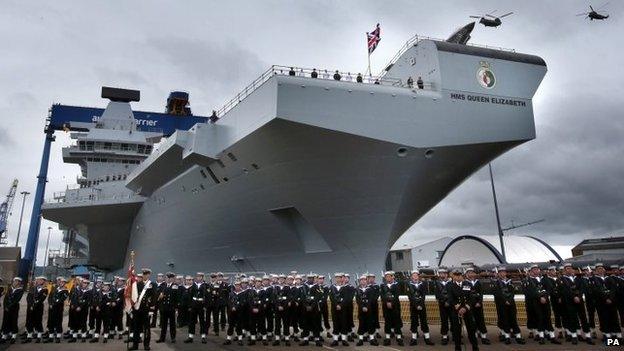
HMS Queen Elizabeth was formally named earlier this year
It's quite likely that the first squadron of fighters to operate from the Royal Navy's new aircraft carrier will belong to the US Marines rather than Britain, naval insiders have told me.
Asked about such a scenario on Newsnight, General Lord David Richards, until earlier this year the UK's top serviceman, said it "would make good sense".
Under current plans there will be a gap in 2019-2020 in which HMS Queen Elizabeth will be ready but not its British air squadron, whereas the Americans are taking delivery of more aircraft and doing so more quickly.
If an emergency like the 2011 Nato bombing of Libya were to occur, the Royal Navy's new flagship might then go into battle as a platform for US jets.
So if the US Marines can fill in for a couple of years, and there's a long history of co-operation anyway, what's the problem?
Totemic carrier
The answer lies in the enormous sensitivity of the aircraft carrier issue, as a totem of the UK and Royal Navy's global ranking, as well as in looming threats to the defence budget with cuts expected after the general election.
Possession of an aircraft carrier, particularly one with powerful strike aircraft capable of hitting targets ashore as well as defending a fleet from air attack, has long been regarded as a totemic thing for the Royal Navy.
Admirals talk about remaining "in the first division of navies".
It was the cancellation of such a ship in 1966 that caused the resignation of both the First Sea Lord and a minister.
The F-35B has the ability to land vertically on aircraft carriers
And again in 1981, a plan to dispose of the baby carriers Britain was by then buying triggered a ministerial resignation.
Admiral Sir Jonathon Band reportedly threatened to resign as naval chief four years ago to save the Queen Elizabeth from the axe.
It is a measure of the emotion and political sensitivity aroused by the carrier issue that Michael Fallon, the defence secretary, on Thursday described suggestions the US might use Britain's ship as "completely incorrect".
Yet the Ministry of Defence agrees that US Marine F35 aircraft will be using the British ship from 2018 onwards.
And it told the BBC on Wednesday that it was not only working closely with the US armed forces to regenerate UK carrier capability, but would also "will seek further opportunities to do so in the future."
'Financial Death Stars'
The current project for two Queen Elizabeth class carriers, the largest warships ever built in Britain, has already shown itself to be deeply politically problematic for this government.
Many Conservatives feel the ships were bought as a political gesture by Gordon Brown in order to pump money into the Clyde.
The colossal cost - £6bn and rising - caused one defence chief to characterise the vessels to me as "financial Death Stars".
In truth, that price tag is just the starting point for a fully fledged "carrier capability".
These big ships will need escorting by frigates and destroyers if they are not to be sitting ducks.
Thousands will have to be trained to operate them; bombs, missiles and other stores will have to be acquired too.
And then of course there's the matter of the aircraft.
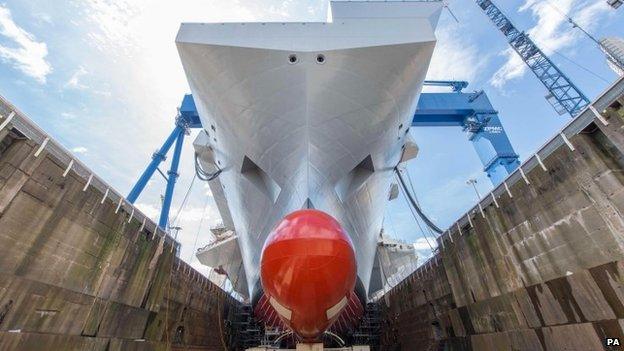
More than 10,000 people worked on HMS Queen Elizabeth's construction
The new F-35 plane has been a big political headache in its own right.
It was meant to be in service by now, but has been plagued by software and other technical problems.
Currently the UK hopes to have its first land-based squadron ready by 2018 and its sea-based one by the end of 2020 or 2021.
The Ministry of Defence said it was "not aware" of any further slippage in those dates.
But others have insisted to me that the slow ordering of the plane, and continued questions about how many the UK can really afford, are also having an impact on the carrier project, and increasing the attractiveness of using them as bases for US Marine aircraft too.
Ambition compromised
For much of the past year, the MoD had been expected to buy its first 14 production F-35B aircraft, but when the order finally materialised last month, it was for just four of them.
These early aircraft will be used to start trials on the Queen Elizabeth, but the BBC has also learned that US Marine jets of the same type, and in larger numbers, will begin flying off her in 2018.
Among senior naval and RAF officers there is already nervousness about how many F-35Bs the UK can actually afford - there being little certainty about the number beyond an aspiration expressed for 48.
Earlier this month, Admiral Sir George Zambellas, the current First Sea Lord, warned the Defence Select Committee that "fundamentally we will need enough jets to make those carriers credible as strategic assets".
This ambition has already been compromised in the sense that nobody expects the Queen Elizabeth to sail with, say, 40 British F-35s and a dozen helicopters on board, even though the ships are big enough to carry an air wing of that size.
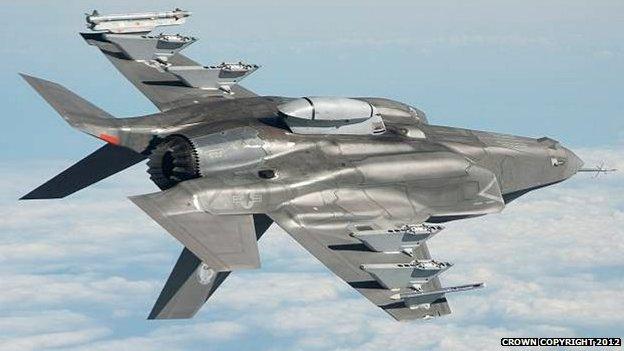
The F-35B will be known as Lightning II when it is in UK service
And, as the 2015 Strategic Defence and Security Review or SDSR gets under way, there will be fresh questions about whether the country can actually afford to operate them as "strike carriers".
"There's a very big spectrum of capability that you can exploit with a carrier," says Air Vice Marshal Sean Bell, formerly a commander of the UK Harrier force.
"I think the decision that we have to make as a nation is can we afford to use these carriers at the high end… or can we operate them down at the [lower] end with a contingency to operate them at the higher end".
Politically charged questions
Under this SDSR outcome, the ships might operate most of the time as helicopter carriers, with F-35s being embarked in emergencies or for specific training exercises.
Bulking up the air component with US Marine jets would be another option.
Few defence insiders think the SDSR next year will scrap either the carriers or the F-35.
Gen Lord Richards, who opposed their construction throughout his time as a defence chief, says ruefully that now they have been built, "not to use them would be almost criminal".
But whether the UK can actually employ the ships to their full capability, or whether they will rely on the US or other allies to escort them into action and fly off them, are different questions, and highly politically charged ones at that.
- Published27 November 2014
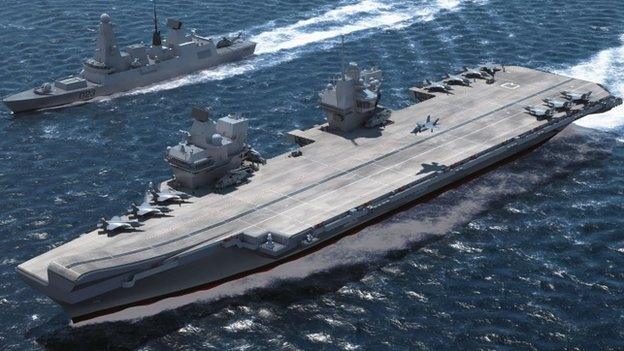
- Published4 July 2014
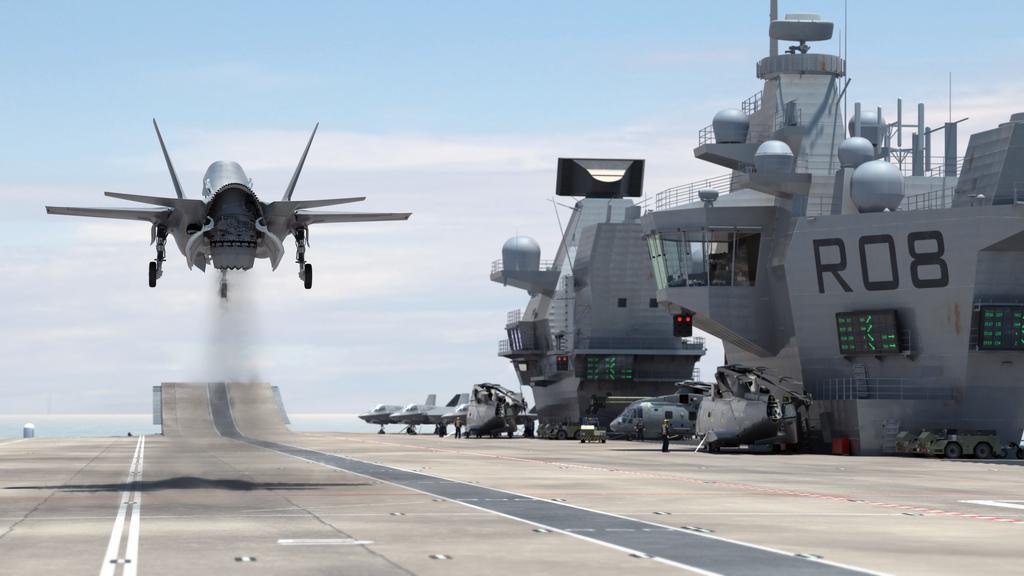
- Published2 July 2014
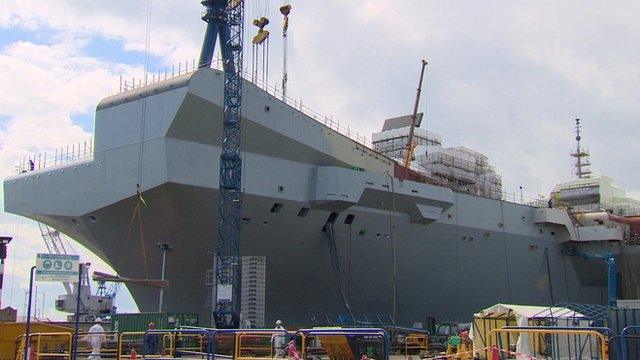
- Published11 February 2014